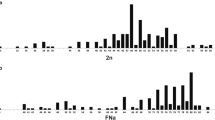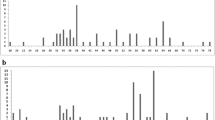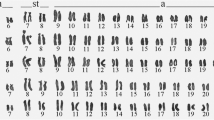Summary
In contrast to the situation found in two classes of warm-blooded vertebrates, mammals and birds, the class Reptilia is not uniform with regard to total genetic content; rather, it contains two distinct categories. The close cytological kinship between snakes and birds was revealed. Both are almost identical in total genetic content, which is about 50 per cent that of placental mammals. Both have microchromosomes, as well as Z-chromosomes very similar in absolute size, comprising nearly 10 per cent of the homogametic haploid (AZ) set. This leads to the implication that snakes and birds originated from the same lineage, and that their Z-chromosomes have not changed substantially since the Jurassic period of the Mesozoic era, about 180 million years ago.
Within the reptilian suborder Serpentes, the step-by-step differentiation from the primitive ZW pair to the grossly heteromorphic ZW pair could be observed. In the ancient family Boidae, the sex chromosomes were still homomorphic to each other. In the family Colubridae, the beginning of heteromorphism was manifested in two ways. In some species, a pericentric inversion on the W caused it to differ from the Z; in others, duplication of the W occurred. In the family Crotalidae, the W had apparently achieved its very specialized status; it was a distinctly smaller element.
Similar content being viewed by others
References
Allfrey, V. G., A. E. Mirsky, and H. Stern: The chemistry of the cell nucleus. Advanc. Enzymol. 16, 411–500 (1955).
Beçak, W., M. L. Beçak, and H. R. S. Nazareth: Karyotypic studies of two species of South American snakes (Boa constrictor amarali and Bothrops jara raca). Cytogenetics 1, 305–313 (1962); - Chromosomes of snakes in short term cultures of blood leucocytes. Amer. Naturalist 97, 253–256 (1963a); - Karyotypic studies of South American snakes. Presented before the XI Internat. Cong. Genet., The Hague 1963b.
Brink, J. M. van: L'expression morphologique de la digametie chez les sauropsidés et les monotrémes. Chromosoma (Berl.) 10, 1–72 (1959).
Kobel, H. R.: Heterochromosomen bei Vipera berus L. (Viperidae, Serpentes). Experientia (Basel) 18, 173–174 (1962).
Mandel, P., P. Métais et S. Cuny: Les quantités d'acide désoxypentose-nucléique par leucocyte chez diverse espèces de Mammifères. C. R. Acad. Sci. (Paris) 231, 1172–1174 (1950).
Matthey, R., et J. M. van Brink: La question des hétérochromosomes chez les Sauropsidés. I. Reptiles. Experientia (Basel) 12, 53 (1956).
Ohno, S.: Sex chromosomes and microchromosomes of Gallus domesticus. Chromosoma (Berl.) 11, 484–498 (1961).
— W. Beçak, and M. L. Beçak: X-autosome ratio and the behavior pattern of individual X-ohromosomes in placental mammals. Chromosoma (Berl.) 15, 14–30 (1964a).
—, C. Stenius, L. C. Christian, W. Beçak, and M. L. Beçak: Chromosomal uniformity in the avian subclass Carinatae. Chromosoma (Berl.) 15, 280–288 (1964b).
Weiler, C., and S. Ohno: Cytological confirmation of female heterogamety in the African water frog (Xenopus laevis). Cytogenetics 1, 217–223 (1962).
Witschi, E.: Age of sex-determining mechanisms in vertebrates. Science 130, 372–375 (1959).
Author information
Authors and Affiliations
Additional information
In Säo Paulo, this work was supported by Fundacão de Amparo a Pesquisa do Estado de São Paulo e Fundo de Pesquisas do Instituto Butantan. In Duarte, this work was supported in part by grant CA-05138-05, National Cancer Institute, U. S. Public Health Service. Contribution No. 36-64, Department of Biology, City of Hope Medical Center.
Rights and permissions
About this article
Cite this article
Beçak, W., Beçak, M.L., Nazareth, H.R.S. et al. Close karyological kinship between the reptilian suborder serpentes and the class aves. Chromosoma 15, 606–617 (1964). https://doi.org/10.1007/BF00319994
Received:
Issue Date:
DOI: https://doi.org/10.1007/BF00319994




